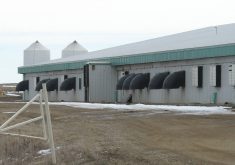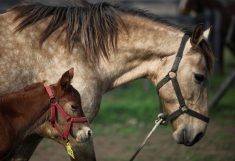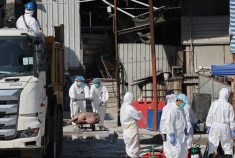The hog sector is considering a proposed ‘compartmentalization’ framework that will come into play should African swine fever arrive in Canada.
Unlike zoning, in which authorities lay out control zones once disease is detected, the compartmentalization program would create rigorously monitored ASF-free ‘compartments’ to operate within the value chain as a matter of course — well before ASF would be found.
The idea, CPC veterinary counsellor Dr. Egan Brockhoff said, would be to create bubbles that could continue to do business freely, even within an ASF control zone. Operations or cross-sections of the sector would apply for compartment status, and would be audited to ensure management meets the standards set out on biosecurity, testing, etc.
Read Also

Beekeepers want financial protection against tropi mite
Tropilaelaps (tropi) mites haven’t landed in Canada yet; beekeepers want to know they’ll get federal financial help if the deadly bee parasite ever does
Anything from outside a designated compartment is therefore treated as if it is an active risk for ASF, regardless of if the disease has ever been found domestically.
“The national compartments program is designed as if ASF is already present, so there’s no changes required when disease occurs,” Brockhoff said. “Our goal when we started this was to achieve zero downtime.”
Why it matters: The pork sector hopes the voluntary compartmentalization program will dodge market disruptions should the worst happen on ASF.
The Canadian Pork Council (CPC) and Canadian Food Inspection Agency unveiled the full framework and standards March 18.
The documents are the work of two years of consultation, Brockhoff said.
The vision, Brockhoff said, would be a voluntary compartmentalization program to work in concert with zoning agreements, all in an effort to decrease market disruption, should ASF be found on Canadian soil.
“As we’ve looked at other countries around the world that have been infected by African swine fever that have robust zoning agreements, we still see a significant market disruption,” he said. “And so we’re really focusing on a program here that can help us protect business continuity.”
What are the rules?
The extensive standards document would cover four areas — biosecurity, surveillance, traceability and segregation, webinar attendees heard.
Each level of production within a compartment must be assigned a health unit (for example, a single barn or age group of pigs), for which a unique mortality threshold must be set. Standards then lay out the procedure for investigation and testing, should mortalities exceed that threshold.
Compartments must also submit a feed plan as part of their application, including a plan to mitigate the risk of feed exposure to wild pigs and a risk assessment of all “pathways for the introduction of ASF.”
Other rules include forbidding workers within a compartment from keeping any of their own swine, vehicle disinfection when re-entering a compartment, tightened rules around traffic zones and service provider access, as well as weekly tests and other requirements for boars coming into an AI centre from outside a compartment. The program would also tighten the timeline for reporting animal movement to PigTrace (down from seven days to 48 hours), require that animals from within compartments remain physically separate in high-traffic facilities where there are other pigs and require that animals delivered for processing be slaughtered within 36 hours, among other rules around cleaning, segregated meat storage, meat traceability, etc.
Industry reaction
The standards are stringent for day-to-day operations, said Cam Dahl, general manager of the Manitoba Pork Council. At the same time, he said, they must be so.
Much of Manitoba’s pork sector relies on export, he noted, making consistent market access in the face of a disease threat critical to the health of the sector.
By that measure, the idea of a compartment able to maintain trade, even in an area with active ASF cases, is very attractive to the council.
“Yes, there would be a requirement for considerable management, considerable biosecurity protocols in place,” he said. “Yes, there’s large requirements in place, but that’s to be expected.
“It wouldn’t be easy to do. It’s difficult. It would cost money. It would cost a lot of management effort, but we would be able to keep shipping product, and that’s the key outcome we’re looking for.”
Another major issue involves service providers, he acknowledged.
Brockhoff advised that service providers attending multiple compartments would have to, themselves, apply as an independent certified facility under the program.
Further complications would arise if some of that service provider’s customers were within a compartment, while others were not.
While the framework and standards leave room for free business between compartments, any operation not associated with a compartment would be considered a disease risk under the framework.
“We absolutely have to include everyone that comes onto the farm into the discussions and around biosecurity,” Dahl said. “When it comes to operations that might be looking to service barns both inside and outside of a compartment, I think that would be difficult. It would require the operation in the compartment to make adjustments.”
Of the several service providers, processors and other pork companies contacted by the Manitoba Co-operator, only Maple Leaf Foods provided comment.
The company supports efforts to create a national compartmentalization framework and standards, a representative said in an emailed statement.
“Canadian efforts to develop an ASF compartmentalization program represent global leadership in ASF control,” they said. “A compartmentalization standard will be essential in enabling our company and other members of Canada’s pork industry to continue trading in pork in the event African swine fever occurs in Canada.”
The company is reviewing the documents and expects to submit comments by the June deadline.
The framework will not be for every operator in the pork sector, Brockhoff acknowledged.
That said, he added that there are several Canadian companies that have expressed serious interest in applying as a compartment.
The Manitoba Pork Council does not see any immediately pressing issues in the standards that they feel need to be addressed, Dahl said. In general, however, he expects the documents will see some amendments.
“This is closer to the beginning of the conversation than the end of it,” he said.
Full text of the proposed framework and standards have been published on the CPC website. Comments on the compartments program can be submitted by email at [email protected].
















